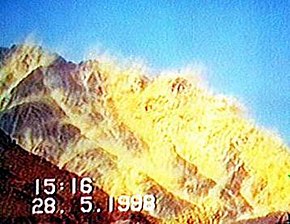| Project 706 | |
|---|---|
 After nine years of effort Project-706 was vindicated in Pakistan's first nuclear test, Chagai-I, 28 May 1998. | |
| Active | 1974–1983 |
| Disbanded | 11 March 1983 |
| Country | Pakistan |
| Allegiance | |
| Branch | Pakistan Army Corps of Engineers |
| Nickname(s) | Kahuta Project |
| Colours Code | Green and White |
| Engagements | Cold War Operation Opera Operation Smiling Buddha Soviet–Afghan War |
| Commanders | |
| Notable commanders | |
| Insignia | |
| Insignia |  |
Project-706, also known as Project-786 was the codename of a research and development program to develop Pakistan's first nuclear weapons.[1] The program was initiated by Prime Minister Zulfiqar Ali Bhutto in 1974 in response to the Indian nuclear tests conducted in May 1974. During the course of this program, Pakistani nuclear scientists and engineers developed the requisite nuclear infrastructure and gained expertise in the extraction, refining, processing and handling of fissile material with the ultimate goal of designing a nuclear device. These objectives were achieved by the early 1980s with the first successful cold test of a Pakistani nuclear device in 1983.[2] The two institutions responsible for the execution of the program were the Pakistan Atomic Energy Commission and the Kahuta Research Laboratories, led by Munir Ahmed Khan and Abdul Qadeer Khan respectively. In 1976 an organization called Special Development Works (SDW) was created within the Pakistan Army, directly under the Chief of the Army Staff (Pakistan) (COAS). This organization worked closely with PAEC and KRL to secretly prepare the nuclear test sites in Baluchistan and other required civil infrastructure.[3]
It was a major scientific effort of Pakistan.[4][5] Project-706 refers specifically to the period from 1974 to 1983 when it was under the control of former Prime Minister Zulfikar Ali Bhutto, and later on under the military administration of General Muhammad Zia-ul-Haq. The program's roots lay in scientists' fears since 1967 that India was also developing nuclear weapons of its own.
Time magazine has called Project-706 Pakistan's equivalent of the United States Manhattan Project.[5] The project initially cost US$450 million (raised by both Libya and Saudi Arabia) and was approved by Bhutto in 1972.[6]
Project-706 led to the creation of multiple production and research sites that operated in extreme secrecy and ambiguity. Apart from research and development the project was also charged with gathering intelligence on Indian nuclear efforts. The Project was disbanded when the Pakistan Atomic Energy Commission (PAEC) carried out the first cold test of a miniature nuclear device on 11 March 1983. Scientists and military officers who participated in the Project were given leadership positions in their respective services, and conferred with high civil decorations by the Government of Pakistan.
- ^ Khan, Feroz (2012). Eating Grass: The Making of the Pakistani Bomb. Stanford University Press. p. 429. ISBN 9780804784801. Archived from the original on 16 January 2023. Retrieved 15 April 2022.
- ^ Rizvi, Hasan-Askari (December 2001). "Pakistan's Nuclear Testing". Asian Survey. 41 (6). jstor.org: 943–955. doi:10.1525/as.2001.41.6.943. JSTOR 10.1525/as.2001.41.6.943. Archived from the original on 27 March 2022. Retrieved 27 March 2022.
- ^ Khan, Feroz (2012). Eating Grass: The Making of the Pakistani Bomb. Stanford University Press. p. 118. ISBN 9780804784801. Archived from the original on 16 January 2023. Retrieved 15 April 2022.
- ^ "Roots of Pakistan Atomic Scandal Traced to Europe". Nuclearactive.org. 19 February 2004. Archived from the original on 27 July 2011. Retrieved 2 September 2010.
- ^ a b "Who Has the Bomb". TIME. 3 June 1985. Archived from the original on 19 May 2011. Retrieved 2 September 2010.
- ^ "Research Library: Country Profiles: Pakistan". NTI. Archived from the original on 9 July 2010. Retrieved 2 September 2010.
